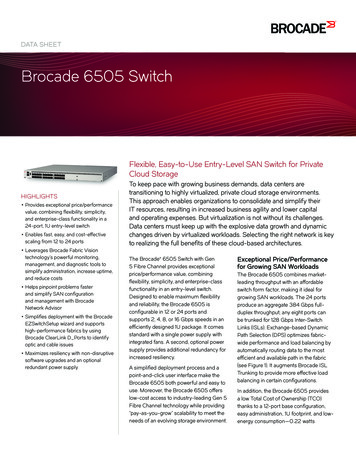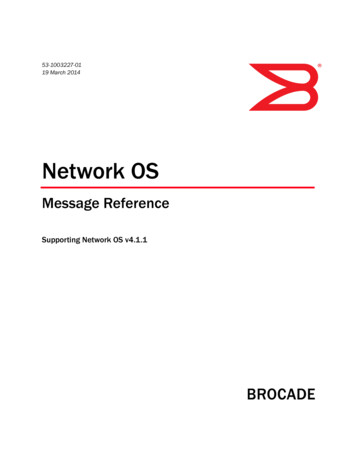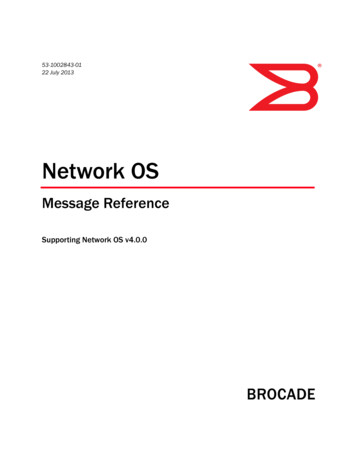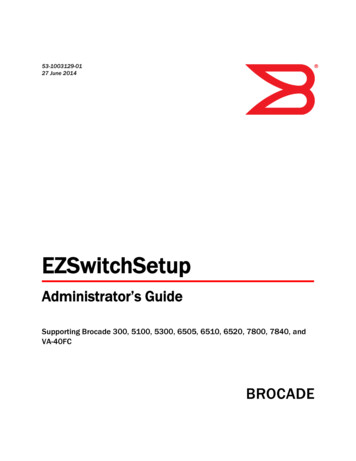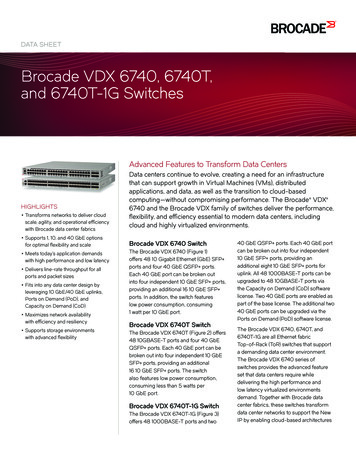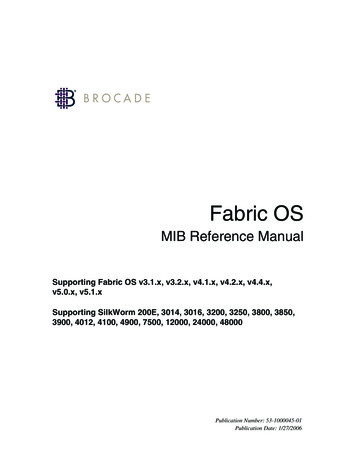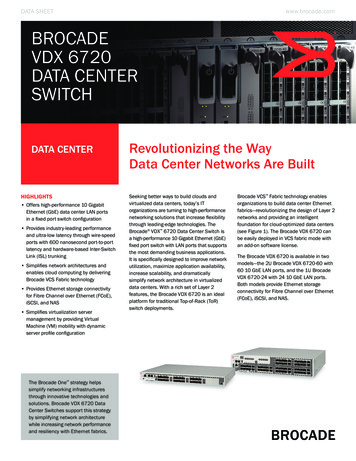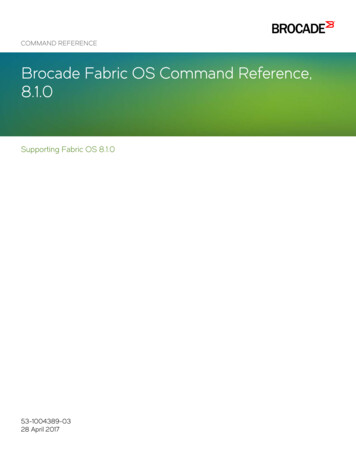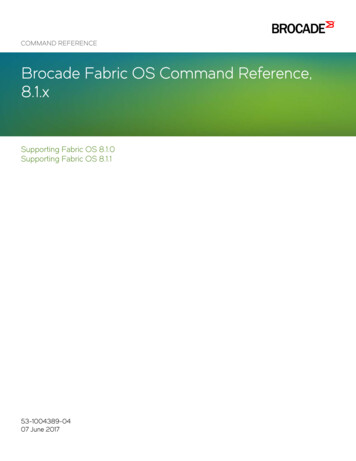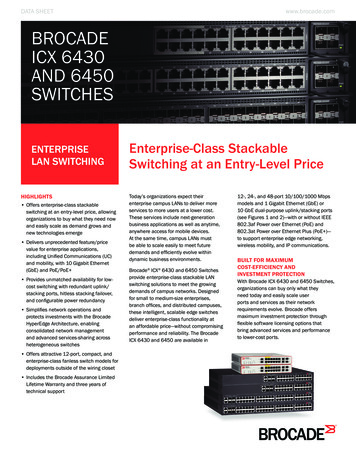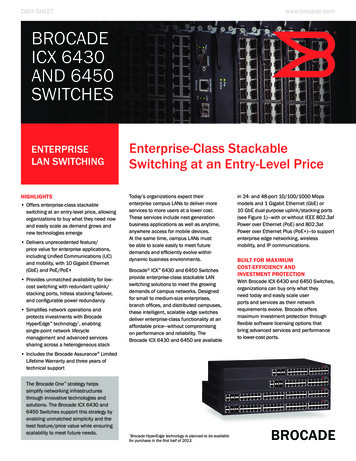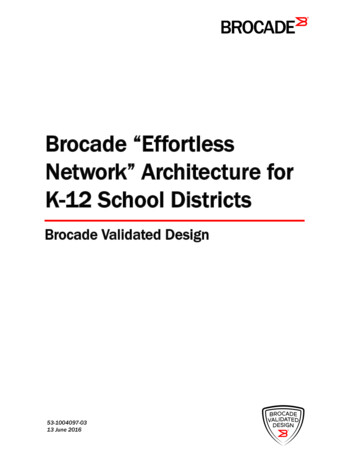
Transcription
Brocade “EffortlessNetwork” Architecture forK-12 School DistrictsBrocade Validated Design53-1004097-0313 June 2016
2016, Brocade Communications Systems, Inc. All Rights Reserved.Brocade, Brocade Assurance, the B-wing symbol, ClearLink, DCX, Fabric OS, HyperEdge, ICX, MLX, MyBrocade, OpenScript, VCS, VDX,Vplane, and Vyatta are registered trademarks, and Fabric Vision is a trademark of Brocade Communications Systems, Inc., in the UnitedStates and/or in other countries. Other brands, products, or service names mentioned may be trademarks of others.Notice: This document is for informational purposes only and does not set forth any warranty, expressed or implied, concerning anyequipment, equipment feature, or service offered or to be offered by Brocade. Brocade reserves the right to make changes to this documentat any time, without notice, and assumes no responsibility for its use. This informational document describes features that may not becurrently available. Contact a Brocade sales office for information on feature and product availability. Export of technical data contained inthis document may require an export license from the United States government.The authors and Brocade Communications Systems, Inc. assume no liability or responsibility to any person or entity with respect to theaccuracy of this document or any loss, cost, liability, or damages arising from the information contained herein or the computer programs thataccompany it.The product described by this document may contain open source software covered by the GNU General Public License or other opensource license agreements. To find out which open source software is included in Brocade products, view the licensing terms applicable tothe open source software, and obtain a copy of the programming source code, please visit http://www.brocade.com/support/oscd.
ContentsPreface. 5About Brocade. 5Brocade Validated Designs. 5Document History.5Purpose of This Document.6Target Audience. 6Introduction.7K-12 Reference Architecture. 9School Network Architecture .11Access Layer. 11Distribution Layer. 12District Office Network Architecture.13Solution Components—Hardware and Software. 15Product Details.15Layer 2 Network Design. 17Network Device Discovery. 17Stacking. 18Link Aggregation Groups. 20VLANs. 21Spanning Tree Protocol.22Uni-Directional Link Detection.23BPDU Guard. 24Edge Ports. 25Root Guard.25Power over Ethernet. 26Layer 3 Network Design.29Unicast Routing Design.29OSPF Routing Design.29BGP Internet-Connectivity Design. 31Multicast Routing Design. 36PIM-SM. 36IGMP/MLD Snooping. 37Multicast Configuration Details.37Network Security Design.41Brocade “Effortless Network” Architecture for K-12 School Districts Brocade Validated Design53-1004097-033
Device Access Security.41RADIUS.41Secure Shell.42Network Access Security. 43IPv4 Access Control Lists. 47DoS Attack Mitigation.48Smurf Attack.48TCP SYN Attack.49Network Services. 51Network Time Protocol.51DHCPv4 and DHCPv6. 51Simple Network Management Protocol.53Recommendations for K-12 SNMP Deployment.53Quality of Service.55Network Management.59Brocade Network Advisor.59Network Element Discovery and Management. 59Traffic Monitoring and sFlow. 60PoE Management. 60Brocade Network Advisor Server Requirements.60SNMP Settings on Brocade Network Advisor. 60Sample Flow (sFlow).62Traffic Management Using Brocade Network Advisor. 63PoE Management Using Brocade Network Advisor. 63Event Notification. 64Configuration Backup.66Glossary. 694Brocade “Effortless Network” Architecture for K-12 School Districts Brocade Validated Design53-1004097-03
Preface About Brocade. 5 Brocade Validated Designs. 5 Document History.5 Purpose of This Document.6 Target Audience. 6About BrocadeBrocade (NASDAQ: BRCD) networking solutions help the world's leading organizations transitionsmoothly to a world where applications and information reside anywhere. This vision is designed todeliver key business benefits such as unmatched simplicity, non-stop networking, applicationoptimization, and investment protection.Innovative Ethernet and storage networking solutions for data center, campus, and service providernetworks help reduce complexity and cost while enabling virtualization and cloud computing to increasebusiness agility.To help ensure a complete solution, Brocade partners with world-class IT companies and providescomprehensive education, support, and professional services offerings (www.brocade.com).Brocade Validated DesignsBrocade Validated Designs are reference architectures that are created and validated by Brocadeengineers to address various customer deployment scenarios and use cases. These validated designsprovide a well-defined and standardized architecture for each deployment scenario, and theyincorporate a broad set of technologies and feature sets across Brocade's product range that addresscustomer-unique requirements. These designs are comprehensively validated end-to-end so that thedesign solutions and configurations can be deployed more quickly, more reliably, and more predictably.Brocade validated designs are continuously validated using a test automation framework to ensure thatonce a design has been validated, it remains validated on new software releases and products.Document HistoryDateVersionDescription10/26/20151.0Initial version.11/23/20152.0Formatting changes.6/13/20163.0New software release recommendations.Brocade “Effortless Network” Architecture for K-12 School Districts Brocade Validated Design53-1004097-035
Purpose of This DocumentPurpose of This DocumentThis Brocade validated design provides building blocks and reusable validated design templates thatare tailored for the unique requirements of K-12 school districts.Target AudienceThis document is written for Brocade system engineers and K-12 network administrators who design,implement, and support K-12 networks.6Brocade “Effortless Network” Architecture for K-12 School Districts Brocade Validated Design53-1004097-03
IntroductionThe primary objective of this document is to provide a solid foundation to facilitate successful K-12designs and deployments that effectively meet current and future requirements. This document providestechnical guidance for network solutions that are suggested for K-12 deployments. It discusses thevarious topologies and Brocade validated configurations for seamless network performance andscalability with Brocade switches and routers.K-12 network design and infrastructure are driven by continuously evolving technology. Networkadministrators and those responsible for building the infrastructures required to support today'sdemanding communications needs are under increasing pressure to maintain and scale their networks.Many trends are impacting this requirement. Seamless connectivity is no longer a matter of ensuringreliable connectivity for the local area network. The network must extend communications outside andmust reach coverage areas that are often many miles away, which remains an important educationaltool that cannot be ignored. Network connectivity-for streaming video, distance learning, and the wealthof Internet-based tools-brings the world into the classroom. With new technologies in place, videos areno longer rolled from room to room on a cart, and computers are not the only classroom tools. Devicesare connected either locally or widely through the Internet.The need for network connectivity means having a robust and flexible infrastructure to satisfy theevolving requirements of the school. The network must support a wide variety of network applicationswithin the classroom and throughout the school district. These applications include: Internet, intranet, and e-mailCommunicationsDistance learningPhonesVideoAdministrative tasksSecurityBuilding automationSmart board and collaborationThis document discusses the Brocade Validated Design to fulfill the network considerations for K-12schools, with an emphasis on the classroom and these diverse applications. The documentencompasses the fact that the technologies and applications embedded in Brocade switches aredesigned to support the evolving requirements today and also to future-proof the network.Brocade “Effortless Network” Architecture for K-12 School Districts Brocade Validated Design53-1004097-037
Introduction8Brocade “Effortless Network” Architecture for K-12 School Districts Brocade Validated Design53-1004097-03
K-12 Reference ArchitectureBrocade's recommended design for K-12 school districts uses an optimized two-tier architecture thataddresses the unique requirements for school districts. A minimal number of network devices can beused to deliver cost-effective, scalable networks that easily interconnect through a Metropolitan AreaNetwork (MAN). This design also provides network connectivity to the Internet and the data center inthe district office. This solution is scalable, supporting various school types such as elementary, middle,and high schools in a school district.The reference design is built with templates, which can be replicated across all campuses, making iteasier to build and manage the network. Two such templates, which are connected via a MAN, aredefined: School template District office templateThe following figure shows Brocade's K-12 school reference architecture.FIGURE 1 K-12 Reference Architecture for School DistrictsBrocade “Effortless Network” Architecture for K-12 School Districts Brocade Validated Design53-1004097-039
K-12 Reference Architecture10Brocade “Effortless Network” Architecture for K-12 School Districts Brocade Validated Design53-1004097-03
School Network Architecture Access Layer. 11 Distribution Layer. 12The school network architecture is modular, so it can be scaled up and scaled out to meet therequirements of different school facilities such as high, middle, and elementary schools.The School template is based on a two-tier architecture: Access layer Distribution layerThe Brocade ICX 7250/7450 switches form the access layer or lower tier of the campus, and theBrocade ICX 7450 switches form the distribution layer or upper tier. Any tier can be managed as asingle entity using Brocade's HyperEdge stacking. Brocade recommends that you run LLDP or CDP onall interfaces of all devices, which helps to identify the peer devices on each link.The following figure shows the School template design.FIGURE 2 K-12 School Network ArchitectureAccess LayerThe access layer of the School template is the connectivity layer for the end-user devices in the schoolcampus to access network services. These end users can use devices such as PCs, laptops, PDAs,smart phones, intermediate devices like wireless access points, and network printers. Each schoolcampus consists of one or more buildings, each of which may have multiple floors, each having one ormore classrooms. The devices positioned in this part of network can be configured in a stack or asBrocade “Effortless Network” Architecture for K-12 School Districts Brocade Validated Design53-1004097-0311
Distribution Layerstandalone devices based upon the number of connected users. For example: Classrooms likecomputer and science labs may require more ports, requiring devices to be stacked. Whereas facilitieslike the gymnasium may need few port connections and can be serviced by a standalone device.Multiple such stacks can be provisioned to scale up the solution as needed. Based upon therequirements, Brocade ICX 7250/7450 devices having PoE and PoE capable ports can be used topower the access devices, such as IP phones and wireless LAN access points. The access layer is primarily a Layer 2 network with associated VLANs for each user group ordepartment. If a user wants to initiate inter-department communication, the same is serviced by thedistribution layer using inter-VLAN routing. Intra-VLAN traffic is handled directly by the accessdevices. Brocade recommends that, for resiliency and bandwidth aggregation, the links toward distributionlayer devices be grouped in a cross-unit LAG configuration. This configuration helps scale theavailable bandwidth as needed. LAGs can be used to bundle multiple individual links into higher bandwidth links while connectingthe access layer to the distribution layer (10 Gbps and higher); this helps to avoid networkbottlenecks. Multiple cross-unit LAGs between the access and distribution layers are used for redundancy, andRapid Spanning Tree Protocol (RSTP) is employed for a Layer 2 loop-free topology.Distribution LayerThe distribution layer in the school provides the Layer 3 routing and the connectivity to the districtoffice for the campus through a Metropolitan Area Network (MAN). The distribution layer terminatesthe Layer 2 traffic within the school and provides Layer 3 network connectivity, including Internetaccess via the district office. In the Brocade K‐12 solution, a stack of Brocade ICX 7450 switches with40-GbE stacking at the distribution layer provides resiliency, high density, significant bandwidth, andadvanced routing functionality. Brocade recommends always using a minimum of two stacked units asa distribution switch. Connectivity to the district office and other campuses via 1/10-GbE uplinksaccommodates higher loads with higher performance. Robust Layer 3 protocols such as OSPF and PIM-SM help route unicast and multicast traffic acrossthe network. The switches in the distribution layer (Brocade ICX 7450) require an Advanced Routinglicense to enable routing in this part of the network design. Application servers are intended to be located in the server farms that are hosted at the districtoffice segment; most of the traffic from schools will be northbound over the MAN links. This designscales well by adding multiple links to the routing process to achieve load-balancing across thelinks.12Brocade “Effortless Network” Architecture for K-12 School Districts Brocade Validated Design53-1004097-03
District Office Network ArchitectureFIGURE 3 K-12 District Office Network ArchitectureFrom the perspective of the school district's network architecture, the district office is the central hub forthe schools where the Metro Ethernet connections to all the school sites aggregate, and it providesupstream connectivity to the Internet. Generally, the district office supports the school district'sadministrative functions and the IT services, and it is also where most of the IT personnel are situated.The district office provides Internet access for all schools in the district, it connects to a service-providersupported WAN using 1-GbE or 10-GbE links, and it connects to the data center network so that theschools can access central applications as required. The district office network includes a firewall, awireless LAN controller, RADIUS, DHCP servers, and Brocade Network Advisor for the networkmanagement and user-access control.The district office connects to the data center network, which hosts the different application servers, forexample, file servers, video servers, call managers, mail servers. These servers provide services likereal-time streaming of audio/video lessons over multicast channels, webcasts, podcasts, video ondemand. This design enables the schools to access central applications as required.The district office network is based on a three-tier architecture: Access layer Distribution layer Internet WAN connectivityThe access layer provides wired and wireless (PoE/PoE ) device access for staff; a dedicated accesslayer stack connects to the server farms, which host applications and other services such as video ondemand. For maximum redundancy, the access stack is a high-bandwidth 40-GbE stack in a ringtopology. The access stack is connected to the distribution stack through a 10-GbE LAG link.The distribution layer in the district office is a very critical part of the K-12 network architecture. BrocadeICX 7750 switches in a stack configuration are used for high availability. The distribution network layerprovides Internet and server-farm connectivity for school campuses and the district office. Schoolcampuses and the district office are connected through a Metropolitan Area Network (MAN). The MANis the service-provider end of the network, which may be owned by the school district itself, and itBrocade “Effortless Network” Architecture for K-12 School Districts Brocade Validated Design53-1004097-0313
District Office Network Architectureprovides network services over the WAN links with the intention of reaching the district office fromindividual schools. The network design assumptions include Layer 3 hand-off for MAN connectivity.For Internet connectivity, the distribution layer connects to two separate MLXe Internet-connectivityrouters. For routing design simplicity, OSPF as an IGP is used between distribution switches andMLXe routers. MLXe routers are connected to the ISP via BGP, and they learn the default route fromthe ISP to direct school Internet traffic via the Internet routers. The learned BGP default route isadvertised to the rest of the network by the OSPF default-information originate mechanism. Thedistribution switches have dual paths toward the MLXe routers for Internet traffic.Alternatively, Brocade ICX 7450 Routers can be used as Internet-connectivity routers; the relevantvalidated configuration template is provided in the "BGP Internet-Connectivity Design" section.For multicast traffic, the distribution layer stack is configured as a static rendezvous point (RP), andPIM-SM is used as the multicast routing protocol on distribution switches. The switches in thedistribution layer (ICX 7750) require an Advanced Routing license to enable routing in this part ofnetwork design.14Brocade “Effortless Network” Architecture for K-12 School Districts Brocade Validated Design53-1004097-03
Solution Components—Hardware and SoftwareThe K-12 network consists of the following components and products.Component/ProductFunctionSoftwareBrocade ICX 7750Distribution switch for the districtofficeSWR08030hBrocade ICX 7450Distribution switch for schoolsSPR08030hAccess switch for the district office(application hosting)Brocade ICX 7250Access switch for schoolsSPS08030hAccess switch for the district officeSPS08030hBrocade MLXe-4Internet-connectivity router05.9.00bBrocade Network AdvisorIntegrated network management12.4.2Product DetailsBrocade ICX 7750—The Brocade ICX 7750 provides unprecedented stacking density and performancewith up to 12 switches per stack and up to 2,880 Gbps of aggregated stacking bandwidth. The switchenables a single point of management across the campus through a distributed chassis architecturethat supports long-distance stacking. It offers industry-leading 10/40-GbE port density and flexibility in a1U form factor with up to 32 40GbE or 96 10GbE ports per unit, saving valuable rack space and powerin wiring closets. It provides chassis-class high availability with six full-duplex 40-Gbps stacking portsper switch, hitless stacking failover, and hot-swappable power supplies and fan assemblies. It providesOpenFlow support in true hybrid port mode, enabling software-defined networking (SDN) forprogrammatic control of network data flows.Brocade ICX 7450—The Brocade ICX 7450 provides a unique modular design with three expansionslots for a choice of 1-GbE, 10-GbE, or 40-GbE uplinks, providing ultimate flexibility and "pay as yougrow" scalability. The switch delivers market-leading stacking scalability with up to 12 switches perstack, 160 Gbps of stacking bandwidth, and long-distance stacking using open-standard QSFP or SFP ports to enable single-point management across the campus. It provides OpenFlow support in truehybrid port mode, enabling software-defined networking (SDN) for programmatic control of network dataflows. It offers Power over HDBaseT (PoH) to power video surveillance and video conferencingequipment, VDI terminals, and HD displays directly from the switch.Brocade ICX 7250—The Brocade ICX 7250 provides market-leading stackability with up to 12 switchesper stack (port scale-out up to 12x24 or 12x48) and up to 80 Gbps of stacking bandwidth. The switchoffers full Power over Ethernet (PoE ) to power wireless access points and video-surveillance andvideo-conferencing equipment. It is manageable via the standard CLI and Brocade Network Advisorenterprise management tool. The switch is future-proof with OpenFlow support for networkprogrammability. Brocade ICX switches support distributed chassis deployment models that usestandards-based optics and cabling interface connections to help ensure the maximum distancebetween campus switches—up to 80 km—and with minimum cabling costs.Brocade MLXe—The Brocade MLXe Series is highly optimized for IP Ethernet deployments, providingsymmetric scaling with chassis options that include 4-, 8-, 16-, and 32-slot systems. The Brocade MLXerouter is designed to meet the requirements of scalability, performance, programmability, andBrocade “Effortless Network” Architecture for K-12 School Districts Brocade Validated Design53-1004097-0315
Solution Components—Hardware and Softwareoperational simplicity. Built with a state-of-the-art, sixth-generation, network-processor-basedarchitecture and terabit-scale switch fabrics, the Brocade MLXe Series provides a rich set of highperformance functionality for Layer 2/3, IPv4, IPv6, Multiprotocol Label Switching (MPLS), wire-speedencryption, and software-defined networking (SDN). As a result, these routers address the diverseneeds of environments that include the service-provider data centers, the enterprise, public sectororganizations, Internet exchange points (IXPs), and research and education networks.Brocade Network Advisor—Brocade Network Advisor greatly simplifies daily operations whileimproving the performance and reliability of the overall Storage Area Network (SAN) and IPnetworking environment. Brocade Network Advisor unifies, under a single platform, the full life-cyclenetwork management for SAN, LAN, and converged networks. Brocade Network Advisor provides aconsistent user experience across the entire Brocade portfolio of switches, routers, and adapters. Thisnetwork management tool offers flexible and proactive SAN/IP network performance analysis inaddition to network configuration change deployment and monitoring for compliance. Brocade NetworkAdvisor supports Fibre Channel SANs, Layer 2/3 IP networks, wireless networks, and MultiprotocolLabel Switching (MPLS) networks for service providers.16Brocade “Effortless Network” Architecture for K-12 School Districts Brocade Validated Design53-1004097-03
Layer 2 Network Design Network Device Discovery. 17 Stacking. 18 Link Aggregation Groups. 20 VLANs. 21 Spanning Tree Protocol.22 Uni-Directional Link Detection.23 BPDU Guard. 24 Edge Ports. 25 Root Guard.25 Power over Ethernet. 26Layer 2 network design forms the basis of effective Layer 2 communication between devices. Thissection deals with the feature sets and protocols that
The Brocade ICX 7250/7450 switches form the access layer or lower tier of the campus, and the Brocade ICX 7450 switches form the distribution layer or upper tier. Any tier can be managed as a single entity using Brocade's HyperEdge stacking. Brocade recommends that you run LLDP or CDP on
